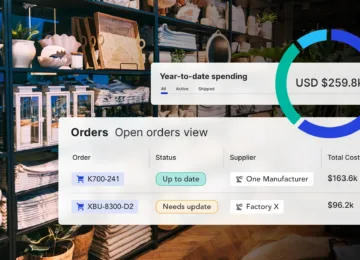Predicting and managing demand is an intricate job for consumer brands. With the rise of omnichannel experiences altering brands’ inventory needs, evolving market trends, and changing global supply chain dynamics adding complexity to inventory management, it’s challenging for brands to anticipate their inventory needs.
As a result, you could be accumulating too much stock. In fact, according to recent Anvyl research, 66% of businesses report being overstocked at present. This represents a significant financial burden for businesses. This is because overstock can:
- Tie up capital that could be allocated to other areas such as marketing or production development
- Erode profit margins given the costs of storage and maintenance
- Force clearance sales or markdowns to liquidate the surplus, further hurting revenue and profits
The bottom line impact of having too much inventory is too stark to ignore. In this blog, we’ll provide 3 tips on how to combat the threat of overstock and streamline inventory management.
1. Lean into the Power of Data-Driven Demand Forecasting
Data-driven demand forecasting plays a crucial role in helping consumer brands reduce overstock and optimize inventory management. By analyzing historical sales data, market trends, and customer behavior patterns, forecasting tools can give you valuable insights into future demand. This allows you to make informed decisions about production and inventory levels, ensuring you meet customer needs without accumulating excess stock.
But the benefits of data-driven demand forecasting tools don’t stop there. They also empower brands to take a proactive approach to inventory management, the importance of which cannot be overstated given the financial implications of getting it wrong. For too long, supply chain managers have had to put out daily fires due to a lack of visibility into demand and forecasting.
By leveraging the power of data-driven demand forecasting, you not only minimize the risk of overstock but improve overall operational efficiency and enhance your ability to respond swiftly to changing market dynamics.
2. Optimize Inventory Turnover
Optimizing inventory turnover is another powerful strategy to combat overstock and more efficiently manage inventory. By focusing on increasing the rate at which products are sold and replenished, you can minimize the accumulation of excess stock. We understand this is much easier said than done, though. So what can you do to optimize inventory turnover?
The key is to regularly assess the performance of your products. By doing this, you can identify slow-moving or obsolete items, and then make a proactive and data-driven decision to expedite their clearance (like sales promotions) or to reduce their production in the future.
This will help you maintain a healthy inventory turnover ratio and empower you to respond more agilely to market fluctuations and customer demands. It also helps ensure you have the right amount of inventory at the right time, optimizing profitability, and maintaining a competitive edge in the market.
3. Enhance Collaboration With Suppliers
You’ll often hear us talk about the value of great supplier relationships. They’re key to a successful supply chain strategy, enabling you to swiftly address PO issues, receive great service, and gain greater visibility into your supply chain’s performance.
One area where having close supplier connections proves particularly fruitful is the fight against overstock. This is because when you have open lines of communication with suppliers, you can work together to align production schedules and optimize inventory levels. It becomes much easier to share accurate sales forecasts, market insights, and customer demand patterns. This promotes better collaboration and builds a more synchronized supply chain as it allows you and your suppliers to adjust your production and deliver schedules accordingly.
Collaborating closely with suppliers can ease the burden of overstock, helping brands to optimize inventory management, minimize holding costs, and maintain a lean and efficient supply chain. All of which ultimately lead to better profitability and a competitive advantage.
To learn more about how Anvyl can help you strengthen your supplier relationships and improve the overall efficiency of your operations, visit here.
Optimizing Inventory Management – And Your Bottom Line
While the tips provided above are our top recommendations for optimizing inventory management and minimizing overstock, there are other ways to reduce excess stock. Some other actions to consider include:
- Implementing just-in-time (JIT) inventory management: This approach focuses on receiving inventory and replenishing stock only when it is needed, just in time for production or customer demand. The goal of JIT inventory management is to minimize inventory carrying costs, reduce waste, and increase operational efficiency. It requires precise coordination and reliable suppliers to ensure timely deliveries, as any disruption in the supply chain can potentially impact production and customer satisfaction.
- Investing in demand sensing technology: These tools use advanced data analytics, machine learning, and real-time data sources to detect and predict customer demand patterns with greater accuracy and agility. You can capture and analyze a wide range of data, including point-of-sale transactions, social media trends, weather conditions, and other external factors that influence consumer behavior. This gives you real-time insights into shifting customer preferences and demand patterns, allowing you to make informed inventory and supply chain decisions.
Fighting overstock and optimizing inventory management starts at the first mile. Contact our team today to learn more about how our intelligent purchase order (PO) management platform tracks, manages, automates, and shares everything from PO issuance to delivery to your warehouse. Book a demo now!



